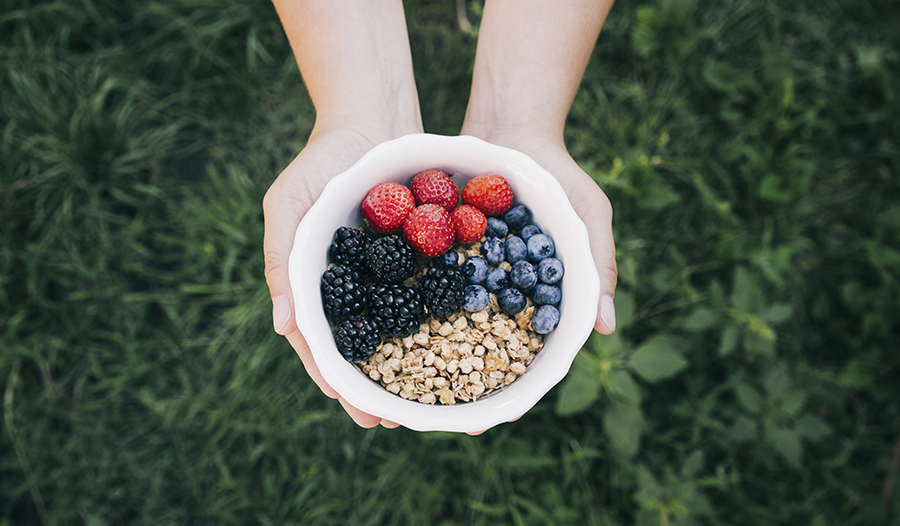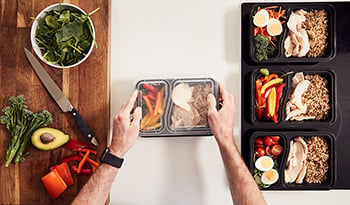How Much Fiber Should We Eat Every Day?

You’ve probably heard that fiber is good for you, but where does fiber come from, and how much should you be consuming every day? Keep reading to get the facts about this important nutrient.
What Is Fiber?
Fiber is the non-digestible part of plants. When you eat vegetables, grains, beans, nuts, and other plants, your body breaks down and absorbs the protein, fat, and carbohydrates. Fiber, on the other hand, passes through your system relatively intact.
There are two main types of fiber found in the foods you eat: soluble and insoluble.
Soluble fiber dissolves in water and helps lower cholesterol, regulate blood sugar and lower the risk of heart disease. Examples of foods that contain soluble fiber include oatmeal, apples, beans, nuts, and blueberries.
Insoluble fiber passes through the body largely intact, helping to keep you “regular” by adding bulk to stools and preventing constipation. Food sources of insoluble fiber include whole-wheat bread, brown rice, cauliflower, and potatoes.
To get the greatest benefits, make sure to consume a good amount of both types of fiber in your diet.
What Are the Health Benefits of Fiber?
Weight Management
Both insoluble and soluble fiber can help you feel more full, which in turn can help you eat less overall. Recent studies show an inverse relationship between fiber intake and body weight. Basically, the more fiber you consume, the better chance you have at losing weight and keeping it off.
Digestive Health
The obvious digestive benefit of having enough fiber in your diet is that it helps you stay regular and avoid constipation. Regular bowel movements may decrease the risk of diverticulosis and diverticulitis. New research is also pointing to fiber’s role in maintaining healthy bacteria levels in the colon by supplying prebiotics (food for good bacteria) and helping you to absorb more nutrients.
Diabetes
For people with diabetes, fiber can help slow down the absorption of sugar in the body, helping to better regulate blood sugar levels. A diet rich in fiber has also been shown to decrease the risk of developing type 2 diabetes.
Cardiovascular Disease
Soluble fiber can help lower both “bad” LDL and total cholesterol. A high fiber diet can also decrease blood pressure and help reduce your risk of cardiovascular disease and stroke.
Overall Health
Multiple studies have shown that fiber-rich diets are associated with a significantly lower risk of dying from any cause. This is great news! Adding more fiber to your diet is a simple and proven way to improve your health right away. How cool is that?
What Is the Recommended Daily Intake of Fiber?
The American Heart Association recommends consuming 25 grams of fiber each day based on a 2,000-calorie diet. Unfortunately, the average American only consumes around 10-15 grams per day.
A recent meta-analysis in The Lancet analyzed over 200 studies and found the greatest disease risk-reduction in people who consumed between 25 and 29 grams per day. Their findings suggested even more protection against cardiovascular disease, type 2 diabetes, and colorectal and breast cancer when the intake went above 29 grams/day.
Which Foods Are Rich in Fiber?
Fruits and vegetables, whole grains, legumes, nuts, and seeds are all important sources of dietary fiber. Some of the best sources are listed below.
- High-fiber cereal
- Cooked beans
- Split peas
- Chickpeas
- Lentils
- Pears
- Avocados
- Apples (with skin)
- Chia seeds
- Bulgur wheat
- Mixed vegetables (cooked from frozen)
- Raspberries
- Blackberries
- Collard greens
- Sweet potatoes (with skin)
- Popcorn
- Almonds
What Are Some Easy Ways to Add More Fiber into My Diet?
- When looking at nutrition labels, make sure the %DV of dietary fiber is above 5%. (Below 5% is considered low fiber, 20% or above is considered high-fiber).
- Look for whole grains on the ingredient list, and remember, the closer an ingredient is to the front of the list, the more of that ingredient is in the food.
- Switch any refined grain products you eat a lot to a whole grain version (for example, pasta, cereal, and bread).
- Choose fruits, veggies, and nuts as snacks instead of highly processed snack foods.
- Add beans, lentils, or peas wherever you can - in soups, on salads, or as a side dish.
- Add chia seeds or flax seeds to your favorite smoothie recipe.
- Aim for only 1/3 of your plate to be meat, filling the other 2/3 with vegetables, legumes and whole grains.
- Incorporate a fiber supplement into your daily routine.
Is it Possible to Consume Too Much Fiber?
While most Americans consume too little fiber, it is possible to overcorrect, especially if you’re trying to increase your intake too quickly.
Make sure to go slowly, building up to your goal over many days to avoid stomach aches and painful bloating. You also want to make sure to drink plenty of water to help the fiber do its job.
If you have any kind of inflammatory bowel disease or IBS, consult your doctor before changing your fiber intake or taking fiber supplements as it could make your condition worse.
Fiber and Overall Health
The overarching message here is that dietary fiber positively impacts overall health in multiple ways, and most people simply aren’t getting enough to reap the benefits. Take a look at what you’re eating most days and if you’re not getting enough fiber, set a goal and work on incorporating more into your diet, slowly but surely building up to at least 25 grams per day.
Here’s a fun recipe to get you started.
High-Fiber Overnight Oats Recipe
Overnight oats take two minutes to throw together at night and two minutes to heat up in the morning (you can even eat them cold if you want to). You get all of the chewy texture of rolled oats without the fuss. Perfect! You can jazz them up any way you want to, but this is the recipe I have been using lately.
Ingredients:
- 1/2 cup rolled oats
- 1/2 cup + 1/4 cup almond milk
- 2 Tbs. chia seeds
- 1 tsp. cinnamon
- 1 Tbs. maple syrup
- 1/2 sliced banana
- High-fiber cereal for sprinkling (optional*)
Instructions:
- Mix oats, 1/2 cup milk, chia seeds, cinnamon and maple syrup in a bowl.**
- Cover and place in refrigerator overnight.
- In the morning, heat for 2 minutes on high in the microwave (can also be eaten cold).
- Add sliced banana and 1/4 milk on top after heating.
- Eat and enjoy!
*For extra fiber and crunch, sprinkle with a high-fiber cereal just before eating.
**For extra flavor, make your overnight oats in a near-empty almond butter or peanut butter jar. Just make sure to heat in a separate container if you don’t want to eat it cold.
PENAFIAN:Hab Kesejahteraan ini tidak berhasrat untuk memberikan diagnosis...













































































 Kandungan
Kandungan















